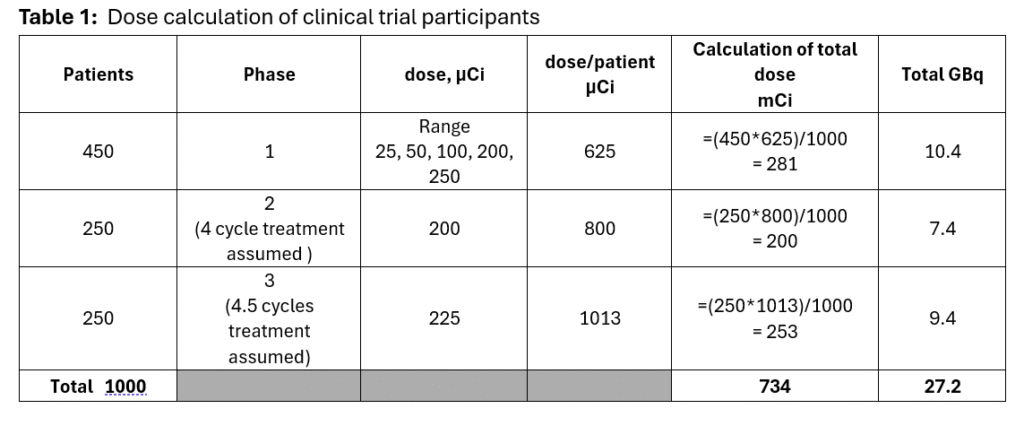Useful for enthusiasts, investors, commercial, management, production and supply chain professionals.
Actinium‑225 (Ac‑225) is a highly sought-after radionuclide for targeted alpha therapy (TAT), an emerging cancer treatment modality. This report outlines the calculations of projected demand for Ac-225 based targeted radiotherapies for which several clinical trials are underway with start of approvals expected in the next 2-3 years with substantial surge in the demand for Ac-225 radioisotope.
About Actinium‑225
Actinium‑225 is the first radioisotope in the Actinide series of the periodic table with a half-life of approximately 9.9 days. It decays by the emission of four α particles and two β– particles to stable Bismuth-209, with α emission as the predominant mode of decay as shown in the figure below.
Figure 1: Particle emissions in Ac-225 decay chain

The α particles emitted are considerably heavier and higher energy (5.8-8.4 MeV) compared to β particles and inflict higher degree of damage to cancer cells while minimizing the impact to normal cells due to their short travel path in the tissues. These characteristics make AC-225 attractive for targeted radiotherapy, particularly for targeting smaller micrometastatic oncologic lesions, described here.
Ac-225 global demand calculations
Demand for Ac-225 in the nuclear medicine stems from:
(a) Clinical trials
(b) Preclinical R&D
(c) Therapeutic application
- (a) Clinical trials
As of May 2025, there are at least 13 active and recruiting clinical trials for Ac‑225-labeled agents registered in the US with clinicaltrials.gov, covering indications such as metastatic prostate cancer (mCRPC), neuroendocrine (NET) tumors, leukemia, and others. While these trials include US and some international studies, additional trials are registered in other regions, e.g., EU and China.
Based on the information from clinicaltrials.gov database, there are about 920 patients currently targeted for enrollment for phase 1-3 trials, with majority in phase 1 and 2 trials, with prostate cancer as the major treatment indication.
We assume current worldwide enrollment target to be ~1000 patients, our best guesstimate.
The requirement of Ac-225 varies with indication, patient weight, phase of a clinical trial and number of treatment cycles required. We do not have exact information on these, therefore some generalized assumptions were required for the estimation of Ac-225 calculations. As the estimate depends on the assumptions, our estimate may differ significantly from other estimates, however, this exercise would provide an approximate idea for the Ac-225 requirement. The assumptions for the calculations were:
- Prostate cancer as the treatment indication
- Average patient weight 75 kg
- 4 treatment cycles assumed for phase 2 and 4.5 cycles (average of 3 and 6 cycles) for phase 3
- Patients and assigned doses for phases 1-3 were based on available data, as shown in Table 1 below.
Table 1 describes the calculation of per patient and total Ac-225 requirement:

The total requirement of Ac-225 calculates to be under 1 Ci, at ~ 734 mCi or 27.2 GBq, a relatively small amount.
Evan if this estimate differs significantly from other estimates, it may not affect the investments for production due to smaller requirement of Ac-225.
- (b) Preclinical R&D requirement calculation
Research groups and preclinical work consume Ac‑225, although at far lower scale. We assume this requirement to be 5-10% of the clinical requirement. This assumption provides Ac-225 requirement for this category at ~ 37-73 mCi or 1.3- 2.7 GBq.
- (c) Therapeutic application requirement calculation
For simplicity, this calculation is performed for prostate cancer indication only. About 313,000 new cases of prostate cancer are expected in 2025, and 8% of those, ~ 25000, are estimated to be mCRPC (ref). The ongoing clinical trials include patients for first line as well as other lines of treatment. Among phase III trials, Ac-225 prostate cancer trials are furthest along, and are likely to be approved in 2027-2028, with SSTR biomarker targeted NET therapy approvals expected to follow in 2029-2030.
The patient pool for therapeutic treatment is far greater than that for clinical trials and would require availability of substantially higher amount of Ac-225.
For calculation, if we assume 20,000 mCRPC patients are treated (every year 25,000 new patients are expected), the required amount of Ac-225 is calculated based on these assumptions:
- average dose of 200 μCi and
- average number of cycles required 4.5 (average of 3-6 treatment cycles)
The dose calculation for this category is shown in Table 2.

Thus, Ac-225 demand would be ~ 18 Ci/year, about 25 times higher than the demand for clinical trial quantities. This demand may be a lot higher for a larger treatment patient pool.
Net demand for three categories combined, based on these calculations, is:

As Ac-225 loses activity post-production during transport and until patient treatment, a loss of 20% activity is assumed (corresponding to average of 2 days between production and patient treatment).
This exercise shows that for the scenarios discussed, 835 GBq or 22.5 Ci of activity needs to be manufactured.
Graphical representation of the Ac-225 requirements is shown below:

There are commercial manufacturers that have stated to establish substantial manufacturing capacity in the next few years. E.g. PanTera, Belgium, states to supply more than 100 Ci n.c.a. Ac-225/year from 2028; NorthStar Medical Radioisotopes states to establish manufacture of ~ 200 Ci/year of n.c.a. Ac-225 at full capacity in the next few years.
